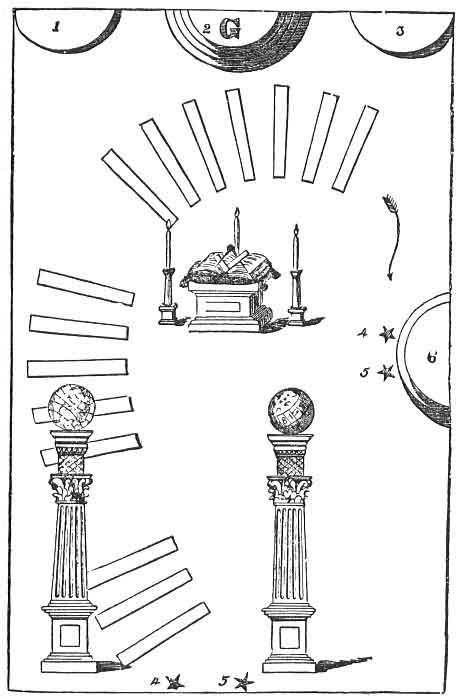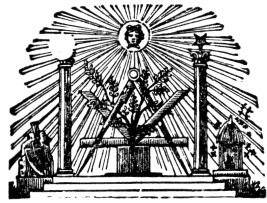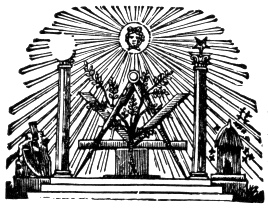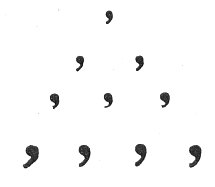p. 71
REPRESENTATION OF THE CRAFTSMAN’S ROAD TO THE MIDDLE CHAMBER OF KING SOLOMON’S TEMPLE.
1. Treasurer 2. Worshipful Master. 3. Secretary. 4, 4. Conductor. 5, 5. Candidate. 6. Junior Warden. p. 72
form, are arranged upon the carpet so as to represent three, five, and seven steps, or stairs. Some Lodges, especially those in the large cities, employ real steps, but in most country Lodges the painted boards are used. For a more definite idea of this arrangement, the reader is referred to Fig. 13.
After the candidate is dressed, the conductor ties upon him a white apron, with the flap turned down, as worn by Fellow Crafts. The conductor then opens the Lodge-door, and, taking the candidate by the left arm, he leads him forward through the door in front of the pillars. For the first position of the parties see Fig. 13, the two stars representing the conductor (i.e. S. D.) and the candidate.
Conductor–Brother Gabe, we are now about to make an ascent through a porch, by a flight of winding stairs, consisting of three, five, and seven steps, to a place representing the Middle Chamber of King Solomon’s Temple, there to receive instructions relative to the wages due, and jewels of a Fellow Craft.
Masonry is considered under two denominations–namely, Operative and Speculative. By Operative Masonry, we allude to the proper application of the useful rules of architecture, whence a structure will derive figure, strength, and beauty; and whence will result a due proportion and a just correspondence in all its parts. It furnishes us with dwellings, and convenient shelters from the vicissitudes and inclemencies of the seasons; and while it displays the effects of human wisdom, as well in the choice as in the arrangement of the sundry materials of which an edifice is composed, it demonstrates that a fund of science and industry is implanted in man, for the best, most salutary, and beneficent purposes.
By Speculative Masonry, we learn to subdue the passions, act upon the square, keep a tongue of good report, maintain secrecy, and practise charity. It is so far interwoven with religion as to lay us under obligations to pay that rational homage to the Deity, which at once constitutes our duty and our happiness. It leads the contemplative to view with reverence and admiration the glorious works of creation, and inspires him with the most exalted ideas of the perfections of his Divine Creator.
Our ancient brethren worked at both Operative and Speculative Masonry; they worked at the building of King Solomon’s Temple, besides numerous other Masonic edifices. They wrought six days, but did not work on the seventh (7th), for in six days God created the heavens and the earth, and rested on the seventh day; therefore our ancient brethren consecrated this day as a day of rest from their labors; thereby enjoying frequent opportunities
p. 73
to contemplate the glorious works of creation, and to adore their great Creator.
Brother, the first thing that particularly attracts our attention are (here the conductor steps forward) two large brazen pillars (pointing at them with his rod), one on the right and one on the left hand. The name of the one on the left hand is Boaz, and signifies strength; the name of the one on the right is Jachin, and denotes establishment; they, collectively, denote establishment and strength, and allude to a passage in Scripture: “In strength shall this house be established.” 1 These are representations of the two pillars erected at the outer porch of King Solomon’s Temple. They are said to have been in height thirty-five (35) (Morgan, Richardson, Bernard, and Allyn say only eighteen) cubits, twelve in circumference, and four in diameter; they are said to have been adorned with two large chapiters of five cubits each, making their entire height forty (40) cubits. These chapiters were ornamented with a representation of net-work, lily-work, and pomegranates, and are said to denote Unity, Peace, and Plenty The network, from its connection, denotes unity; the lily-work, from its whiteness, and the retired place in which it grows, purity and peace; the pomegranates, from the exuberance of their seed, denote plenty. These chapiters have on the top of each a globe, or ball; these globes are two artificial spherical bodies; on the convex surfaces of which are represented the countries, seas, and various parts of the earth, the face of the heavens, the planetary revolutions; and are said to be thus extensive, to denote the universality of Masonry, and that a Mason’s charity ought to be equally extensive. The principal use of these globes, besides serving as maps, to distinguish the outward parts of the earth, and the situation of the fixed stars, is to illustrate and explain the phenomena arising from the annual revolution and the diurnal rotation of the earth around its own axis. They are the noblest instruments for improving the mind, and giving it the most distinct idea of any problem or proposition, as well as enabling it to solve the same.

Moe is the founder of GnosticWarrior.com. He is a father, husband, author, martial arts black belt, and an expert in Gnosticism, the occult, and esotericism.





